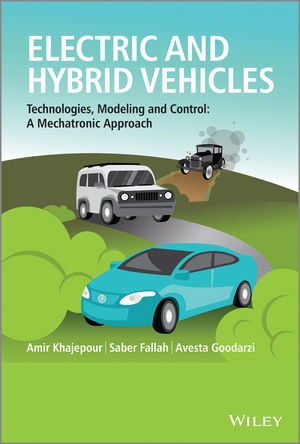Read more
Informationen zum Autor Amir Khajepour University of Waterloo, CanadaSaber Fallah University of Surrey, UKAvesta Goodarzi University of Waterloo, Canada and Iran University of Science and Technology, Iran Klappentext There is significant demand for an understanding of the fundamentals, technologies, and design of electric and hybrid electric vehicles and their components from researchers, engineers and graduate students. This book is based on the authors' current research in vehicle systems and includes chapters on vehicle propulsion systems, the fundamentals of vehicle dynamics, EV and HEV technologies, chassis systems, steering control systems, and state, parameter and force estimations. The book is highly illustrated, and examples are given throughout the book based on real applications and challenges in the automotive industry.* Designed to help a new generation of engineers master the principles of, and further advances in, hybrid vehicle technology* Takes a mechatronics approach to the study of electric and hybrid electric vehicles, appealing to mechanical and electrical engineering interests* Responds to the increase in demand of universities offering courses in newer electric vehicle technologies* Includes examples of real applications and challenges in the automotive industry with problems and solutions Zusammenfassung An advanced level introductory book covering fundamentalaspects, design and dynamics of electric and hybrid electricvehicles There is significant demand for an understanding of thefundamentals, technologies, and design of electric and hybridelectric vehicles and their components from researchers, engineers,and graduate students. Inhaltsverzeichnis Preface xiiiAcknowledgments xv1 Introduction to Vehicle Propulsion and Powertrain Technologies 11.1 History of Vehicle Development 11.2 Internal Combustion Engine Vehicles (ICEVs) 31.3 Vehicle Emission Control Technologies 161.4 Vehicles with Alternative Fuels 251.5 Powertrain Technologies 291.6 Transmission Systems 321.7 Drivetrain and Differentials 412 Electric and Hybrid Powertrain Technologies 472.1 Introduction 472.2 Battery Electric Vehicles (BEVs) 482.3 Fuel-Cell Electric Vehicles (FCEVs) 652.4 Hybrid Electric Vehicles 712.5 Plug-in Hybrid Electric Vehicles (PHEVs) 852.6 Hybrid Hydraulic Vehicles (HHVs) 872.7 Pneumatic Hybrid Vehicles (PHVs) 892.8 Power/Energy Management Systems 912.9 Summary 923 Body and Chassis Technologies 953.1 Introduction 953.2 General Configuration of Automobiles 953.3 Body and Chassis Fundamentals 973.4 Different Types of Structural Systems 1013.5 Body and Chassis Materials 1083.6 Specific Considerations in Body and Chassis Design of Electric and Hybrid Electric Vehicles 1103.7 The Chassis Systems of Electric and Hybrid Electric Vehicles 1264 Vehicle Dynamics Fundamentals 1494.1 Introduction 1494.2 Concepts and Terminology 1494.3 Vehicle Kinematics 1524.4 Tire Mechanics and Modeling 1705 Modelling and Characteristics of EV/HEV Powertrains Components 1815.1 Introduction 1815.2 ICE Performance Characteristics 1825.3 Electric Motor Performance Characteristics 1955.4 Battery Performance Characteristics 2145.5 Transmission and Drivetrain Characteristics 2235.6 Regenerative Braking Characteristics 2335.7 Driving Cycles 2366 Modeling and Analysis of Electric and Hybrid Electric Vehicles' Propulsion and Braking 2456.1 Introduction 2456.2 The Longitudinal Dynamics Equation of Motion 2466.3 Vehicle Propulsion Modeling and Analysis 2476.4 Vehicle Braking Modeling and Analysis 2687 Handling Analysis of Electric and Hybrid Electric Vehicles 2777.1 Introduction 2777.2 Simplified Handling Models 2777.3 Comprehensive Handling Model of EVs and HEVs 2988 Energy/Power Allocation and Management 3138.1 Introduction 3138.2 Power/Energy Management Controllers 3148.3 Rule-Based Control Strategies 315...

